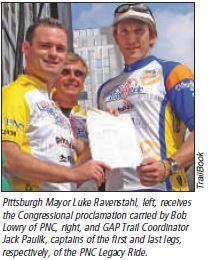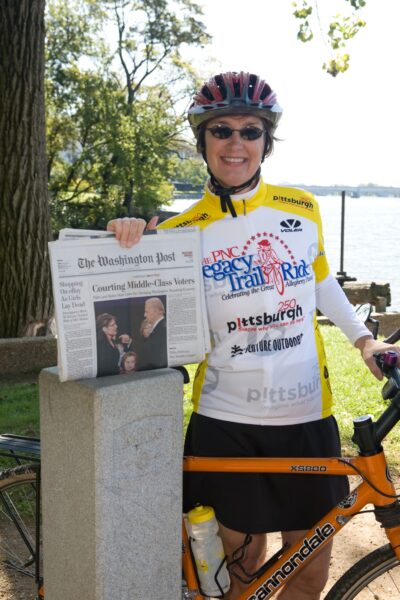Pittsburgh 250th Celebration
“We had also created funding to help get the Hot Metal Bridge constructed. But, there was no route; there was no corridor. And, we didn’t know how we were going to get from Point A – being McKeesport – to the end of Sandcastle. […] Except for the coke-gas pipeline possibility – there was no other piece of real estate that we could build a trail on. So, Pittsburgh 250 saying, ‘Hey, we’ll get this done for you,’ was a godsend. We could not have done it without Pittsburgh 250.”[1]
-Linda M. Boxx, September 15th, 2019
 Immortalized in the name of its celebrated Football team, the Steelers, is a reminder that Pittsburgh was an industrial powerhouse during the late 1800s and well into the 1950s. However, industrialization came with a cost: it ravaged Pittsburgh’s gorgeous natural resources and polluted many of the assets (like the Allegheny, Monongahela, and Ohio Rivers) that Pittsburgh locals use today. For the city’s 250th Anniversary celebrations in October of 2008, Pittsburgh decided to “rebrand” itself as a place of opportunity and innovation.[2] To showcase this new identity, the Pittsburgh 250th centered around three “signature projects” involving recreational and historical components such as:
Immortalized in the name of its celebrated Football team, the Steelers, is a reminder that Pittsburgh was an industrial powerhouse during the late 1800s and well into the 1950s. However, industrialization came with a cost: it ravaged Pittsburgh’s gorgeous natural resources and polluted many of the assets (like the Allegheny, Monongahela, and Ohio Rivers) that Pittsburgh locals use today. For the city’s 250th Anniversary celebrations in October of 2008, Pittsburgh decided to “rebrand” itself as a place of opportunity and innovation.[2] To showcase this new identity, the Pittsburgh 250th centered around three “signature projects” involving recreational and historical components such as:
- Creating a self-guided driving tour called the Forbes Trail which reached statewide landmarks like the Freedom Bell in Philadelphia and regional sites like Fort Ligonier in Westmoreland County.[3]
- Renovating Point State Park with nearly $25 million in state-allocated funding.[4]
- Finalizing the remaining 9 miles between McKeesport and Pittsburgh along the Great Allegheny Passage (GAP) to complete the connection between Pittsburgh and Washington, D.C.[5]
The selection of the GAP as a signature project during the Pittsburgh 250th festivities helped fulfill the notion that the celebration was regional, and not just about Pittsburgh.[6]
Being a signature project came as a pleasant surprise to Linda M. Boxx and the Allegheny Trail Alliance (ATA), who learned that the GAP was selected as a signature project over phone:
“So, sometime in late 2005, I got a call from Laura Fisher from the Allegheny Conference of Community Development [and] I knew Laura because I was on the French and Indian War 250 Board, which was sort of an ancillary, affiliated organization with the Pittsburgh 250. And, she said, ‘Oh, good news! We’d like finishing the GAP to be one of our legacy projects for the Pittsburgh 250 celebration. And, we want to work with you – team up – bring resources to bear and really help you finish the Great Allegheny Passage.’ And, we said, ‘O-o-kay.’”[7]
 Trail development at this point in time was being finalized in Maryland, with no solid real estate acquired between McKeesport and Pittsburgh (up to the Eliza Furnace Trail).[8] Most of the 9 miles needed to reach Pittsburgh were owned by the businesses and corporations, one of the largest property owners was United States Steel Corporation.[9] In 2005 the Linda Boxx helped to coordinated a trail tour to show ACCD members the potential of the GAP, and its challenges. Jack Paulik recalls:
Trail development at this point in time was being finalized in Maryland, with no solid real estate acquired between McKeesport and Pittsburgh (up to the Eliza Furnace Trail).[8] Most of the 9 miles needed to reach Pittsburgh were owned by the businesses and corporations, one of the largest property owners was United States Steel Corporation.[9] In 2005 the Linda Boxx helped to coordinated a trail tour to show ACCD members the potential of the GAP, and its challenges. Jack Paulik recalls:
“So, a bus trip was organized for Allegheny- this is huge – Allegheny Conference people, county executives, conference members such as Cliff [Clifford R.] Rowe [CEO of P.J. Dick Construction and General Contracting], and Bob [Robert H.] Luffy from American Bridge. I mention their names because they are big-time players, okay? They were on the trip. There were CEOs of some of the largest corporations in Pittsburgh.
… And so, we toured the alignment and a couple of things came out of that. Cliff Rowe and Bob Luffy – they’re CEOs in major corporations. Well, we get to the bad section where we were supposed to go up on 837 and ride 837. And, we took them down along the corridor, along the railroad. And, we knew this was the best alignment we didn’t have. They said, ‘Well, you can’t go up on 837. You have to stay on the river and you have to build bridges and cross the railroads back and forth and stay down here. There’s no way you can go up there and make this trail work.’ […] The general comment from these builders was, ‘This is extreme. You can’t do this. This is not where you go to put a bike trail.’ And, we’re like, ‘Okay, we agree to that.’ But, we don’t have the real estate to do it along the railroad.
And, John Surma was listening to this, too. He’s like, ‘Well, maybe we can talk to Norfolk Southern Railroad,’ and I’m telling you, that keeps playing over in my mind. And, here’s the association between U.S. Steel and Norfolk Southern […] The association was, ‘I have a good relationship with Norfolk Southern and they haul a lot of coal and coke for us.’ So, eventually [Surma] said, ‘I’m going to talk to [Norfolk Southern’s] CEO and tell them, ‘Will you guys work with these guys? Just listen to them.’ And, we got their ear.”[10]
 Gaining allies within the ACCD opened up doors for the GAP; it helped trailbuilders meet important landowners and funders around Pittsburgh, including PNC CEO and Pittsburgh 250th Anniversary Commission chairman Jim Rohr.[11] In February 2006 Boxx met with advertising company MARC USA president and Chief Executive Officer Michele Fabrizi to map out a comprehensive marketing plan.[12]
Gaining allies within the ACCD opened up doors for the GAP; it helped trailbuilders meet important landowners and funders around Pittsburgh, including PNC CEO and Pittsburgh 250th Anniversary Commission chairman Jim Rohr.[11] In February 2006 Boxx met with advertising company MARC USA president and Chief Executive Officer Michele Fabrizi to map out a comprehensive marketing plan.[12]
Work along the GAP in trying to secure the last 9 miles (a feat assumed to be an easy accomplishment by the ACCD) would begin in 2006.[13]
Between 2006 and the Pittsburgh 250th deadline in October 2008, much work needed to be done to even start to make headway into Pittsburgh. The RTC acquired the 1.9-mile-long coke-gas pipeline property from the U.S. Steel in 2006, securing the first bit of real estate to spearhead the trail further west.[14] In 2007, completed the Duquesne Underpass, the Hot Metal Bridge, and 1-mile of trail near the Whitaker Bridge site. Thanks to the inclusion of the GAP’s selection as a signature project, many local contributors of funding and construction support worked diligently to meet Pittsburgh 250 trailbuilding goals. One particular example was Cliff Rowe of construction company PJ Dick Trumbull and Tom Carey of Lindy Paving. In honor of the Pittsburgh 250th, both contractors agreed to do work at-cost, meaning they did not profit from their work on the GAP.[15] This sacrifice, while a financial loss for the companies involved, really showcased the influence of the Pittsburgh 250th and the willingness of local companies to come together to see this project through to the end. By early 2008, plans to acquire and renovate the Riverton Bridge were in motion. The ATA struggled to build a route through Sandcastle Water Park and Keystone Iron & Metals, with West Homestead also resisting plans to develop the trail north of the Waterfront. Despite these hang-ups, the Pittsburgh 250th still provided invaluable support for the GAP.
The GAP’s main Pittsburgh 250 event was the PNC Legacy Trail Ride, an 8-day GAPl-oriented series of celebrations that took place all along the 335-mile expanse of the GAP and C&O Canal Towpath.[16] The festivities included:
- “Celebration Saturday” on September 27: Trail towns West Newton, Connellsville, Ohiopyle, Confluence, Meyersdale, and Rockwood provided trail-oriented activities and food, and revealed a public art display linking all the trail towns together.[17]
- A week-long Venture Outdoors 250 Bike Tour sojourn ride from Washington, D.C. to Pittsburgh starting September 28: This trip consisted of approximately 250 bicyclists (later limited to 90) who rode/camped on their journey to Pittsburgh.[18]
- A 24-hour bike relay from Washington, D.C. to Pittsburgh on October 3: The relay showcased 18 teams of 6 riders who carried a Congressional proclamation with them to Pittsburgh.[19]
- A community ride/hike met the sojourn riders and relay participants on October 4: The sojourn, relay, and the general public started at PNC Firstside Center and ended with a community concert and fireworks at Point State Park later that same evening.[20]
The Venture Outdoors sojourn included a plethora of amenities such as a three catered meals a day with snacks, chartered bus transportation from Pittsburgh to D.C. (including additional transportation for hauling bicycles), camping gear ferried to each overnight stop, and optional opportunities for side trips to places like the Antietam Civil War battlefield in Maryland.[21] Approximately 80 riders attended the sojourn and spent from September 28 to October 4 making the 335 mile ride from Washington, D.C. to Point State Park in Pittsburgh, including ACCD CEO Mike Langley.
The PNC Legacy Relay-Ride began around noon on October 3, 2008, with the goal of reaching Point State Park in the afternoon of October 4.[22] The relay consisted of 18 teams of 6 riders each who were stationed along particular points of the 335 miles of the C&O Canal Towpath and the GAP. Lawrence Walsh of the Pittsburgh Post-Gazette wrote about one of the relay points in Rockwood:
“PNC Legacy Trail Relay rider Charlie Beaumariage was in his pajamas when he heard someone tapping on the kitchen window of the Rockwood Trail House Bed and Breakfast in Somerset County.
‘Get dressed,’ said Linda McKenna Boxx, […] ‘They’ll be here in 15 minutes.’
‘I looked at my watch,’ said Mr. Beaumariage, […] ‘It was 4:15 a.m. They were an hour ahead of time.’”[23]
Beaumariage and five others would depart from Rockwood and head to Confluence, where another relay team would meet them. The sojourn group, who would be patiently waiting for the relay’s arrival, met up with the riders in McKeesport. From there onward, riders from the relay, sojourn, and the surrounding community pedaled diligently towards Point State Park.
That evening, fireworks lit up the night sky with brilliant colors. And after the festivities ceased and the riders went home, the trailbuilders got back to work. There was still the coke-gas pipeline to develop and Sandcastle to negotiate with, although on October 3 the president of Kennywood and Sandcastle, Peter J. McAneny, was quoted saying that Allegheny County Executive Dan Onorato and Sandcastle had made “significant progress” to make way for the trail through Sandcastle.[24] With progress on that front, along with the unprecedented support from Pittsburgh businesses and trail enthusiasts, the Pittsburgh 250th Anniversary gave the GAP the publicity boost it needed to fill in the remaining gaps between Homestead and Point State Park.
